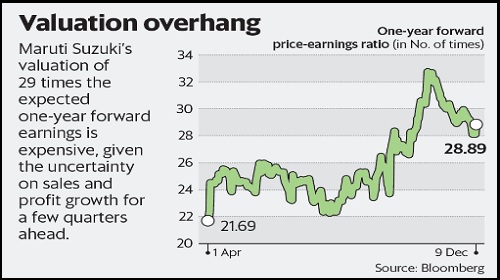That’s not all. Maruti has to clear the BS-IV vehicle inventory before March, which may lead to high discounts. Note that Q2 FY20 blended discounts were the firm’s highest-ever at ₹25,761 per vehicle.
Meanwhile, the Federation of Dealers Association’s like-to-like comparison of the 42-day festive retail demand showed a paltry 1% rise in passenger vehicle registrations. Typically, there is a lull in the months after the festive euphoria. Again, Maruti Suzuki’s price hike in January (already announced) may stymie demand expansion.
A report by Maybank Kim Eng Securities India Pvt. Ltd said: “The firm may be pushed to increase discounts in the second half to liquidate inventory ahead of BS-VI deadline in April 2020 (22% of volume is diesel and 50% of inventory is diesel)." The cushion from softer steel/non-ferrous metal prices may not be able to mitigate this impact. This would stem margin and earnings expansion in the near term.
So, while Maruti Suzuki continues to be the best play on India’s retail auto sector, a full recovery in demand in the remaining three months of FY20 still looks elusive.
“Strong evidence of a demand pick-up is lacking, but instead, one can expect inventory liquidation and, then, price hikes in the first half of FY21 to cover BS-VI technology implementation," added the Maybank report.
" />

Maruti Suzuki India Ltd’s shares rose by just 1.6% after the company announced an increase in production after nine consecutive months of output cuts. Of course, just a 4.3% year-on-year production rise, after a 20% cut between April and October is not much to write home about, leave alone being enough to trigger a rerating in the stock.
In fact, analysts still maintain the estimate of earnings contraction for FY20 and 15-16% growth in FY21. Therefore, the current price of ₹6,994.75, which discounts the one-year forward earnings by 29 times, still looks expensive. Note that its shares have risen about 30% from the lows in July.
Analysts are also not sure if the production ramp-up would continue in the months ahead. November’s production increase could be to fill the dealer pipeline with BS-VI emission-compliant vehicles, after the inventory came down to more reasonable levels during the festive season.

That’s not all. Maruti has to clear the BS-IV vehicle inventory before March, which may lead to high discounts. Note that Q2 FY20 blended discounts were the firm’s highest-ever at ₹25,761 per vehicle.
Meanwhile, the Federation of Dealers Association’s like-to-like comparison of the 42-day festive retail demand showed a paltry 1% rise in passenger vehicle registrations. Typically, there is a lull in the months after the festive euphoria. Again, Maruti Suzuki’s price hike in January (already announced) may stymie demand expansion.
A report by Maybank Kim Eng Securities India Pvt. Ltd said: “The firm may be pushed to increase discounts in the second half to liquidate inventory ahead of BS-VI deadline in April 2020 (22% of volume is diesel and 50% of inventory is diesel)." The cushion from softer steel/non-ferrous metal prices may not be able to mitigate this impact. This would stem margin and earnings expansion in the near term.
So, while Maruti Suzuki continues to be the best play on India’s retail auto sector, a full recovery in demand in the remaining three months of FY20 still looks elusive.
“Strong evidence of a demand pick-up is lacking, but instead, one can expect inventory liquidation and, then, price hikes in the first half of FY21 to cover BS-VI technology implementation," added the Maybank report.
0 thoughts on “Maruti raises output a tad but investors are hoping for more”